What is Augmented Reality?

Definition and Core Concepts
Augmented Reality (AR) is an innovative technology that overlays digital information—such as images, sounds, or other data—onto the real-world environment, enhancing the user’s perception and interaction with their surroundings.
Unlike Virtual Reality (VR), which immerses users in a completely artificial environment, AR maintains a connection to the real world by superimposing computer-generated elements onto it.
Key Characteristics of Augmented Reality
- Integration of Digital and Physical Worlds: AR seamlessly blends digital content with the physical environment, allowing users to interact with both simultaneously. This integration enriches the real world with additional layers of information, making experiences more engaging and informative.
- Real-Time Interaction: A defining feature of AR is its ability to provide real-time feedback. As users move or change their perspective, the digital overlays adjust accordingly, creating a dynamic and interactive experience.
- 3D Registration: AR systems accurately align digital content with real-world objects in three-dimensional space. This precise placement ensures that virtual elements appear as natural parts of the physical environment, enhancing the sense of immersion.
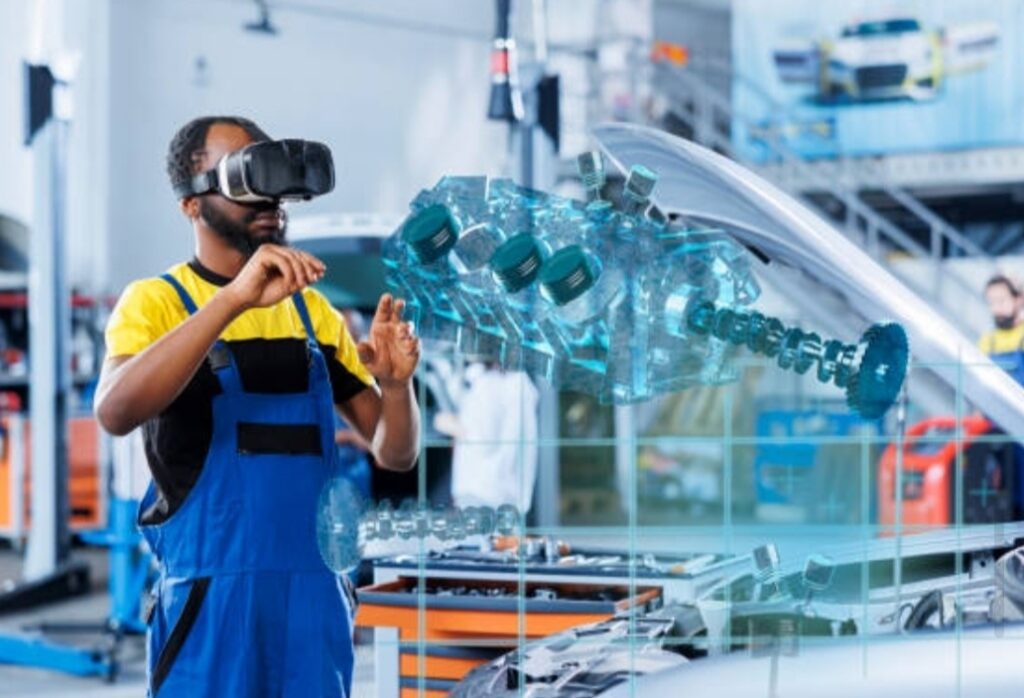
How Augmented Reality Works
The functionality of AR relies on a combination of hardware and software components working in harmony:
- Hardware Components:
- Sensors: Devices such as cameras, accelerometers, and gyroscopes detect the user’s environment and movements, providing essential data for AR applications.
- Processors: Advanced computing power is required to process sensor data and render digital content in real-time.
- Displays: Screens on smartphones, tablets, AR glasses, or headsets present the augmented content to users.
- Software Components:
- Computer Vision: This technology enables AR systems to interpret and understand visual input from the real world, identifying objects and surfaces for accurate overlay placement.
- AR Platforms and Frameworks: Software development kits (SDKs) and platforms, such as ARKit (Apple) and ARCore (Google), provide tools for developers to create AR experiences.
Types of Augmented Reality
AR experiences can be categorized based on how they overlay digital content onto the physical world:
- Marker-Based AR: Utilizes predefined images or patterns, known as markers, to trigger the display of digital content. When the AR system recognizes a marker through the device’s camera, it overlays the corresponding digital information onto the marker’s position.
- Markerless AR: Also known as location-based or position-based AR, this type uses GPS, accelerometers, and other sensors to determine the user’s location and orientation, enabling the overlay of digital content without the need for specific markers.
- Projection-Based AR: Projects light or holograms onto physical surfaces, allowing users to interact with the projected content. This method creates the illusion that digital elements are part of the real-world environment.
- Superimposition-Based AR: Replaces or augments parts of the real-world view with digital elements. For example, an AR application might allow users to see how new furniture would look in their living room by superimposing a digital model over the live camera feed.

Applications of Augmented Reality
The versatility of AR has led to its adoption across various industries:
- Education: AR transforms traditional learning by providing interactive 3D models and immersive experiences, making complex subjects more accessible and engaging for students.
- Healthcare: Medical professionals use AR for tasks such as visualizing patient anatomy during surgeries, enhancing precision, and improving outcomes.
- Retail: AR enables customers to virtually try on clothes or visualize how furniture would fit in their homes, enhancing the shopping experience and reducing return rates.
- Entertainment: Games like Pokémon Go have popularized AR by blending virtual characters with real-world environments, offering users an immersive gaming experience.
Future Prospects of Augmented Reality
As technology advances, AR is poised to become even more integrated into daily life:
- Wearable AR Devices: The development of AR glasses and contact lenses aims to provide seamless and hands-free augmented experiences, making AR more accessible and practical for everyday use.
- Enhanced Connectivity: With the rollout of 5G networks, AR applications can benefit from faster data speeds and lower latency, enabling more complex and real-time interactions.
- Integration with Artificial Intelligence: Combining AR with AI can lead to smarter applications that understand and adapt to user behavior, providing personalized and context-aware experiences.
Augmented Reality represents a significant technological advancement that bridges the gap between the digital and physical worlds.
By overlaying digital information onto our real-world environment, AR enhances the way we perceive and interact with our surroundings.
As AR technology continues to evolve, its applications are expected to expand, offering innovative solutions across various sectors and enriching our daily lives.
How Does Augmented Reality Work?
Augmented Reality (AR) seamlessly blends digital content with the real world, creating interactive and immersive experiences.
Understanding how AR works involves exploring its core components and the various types of AR implementations.
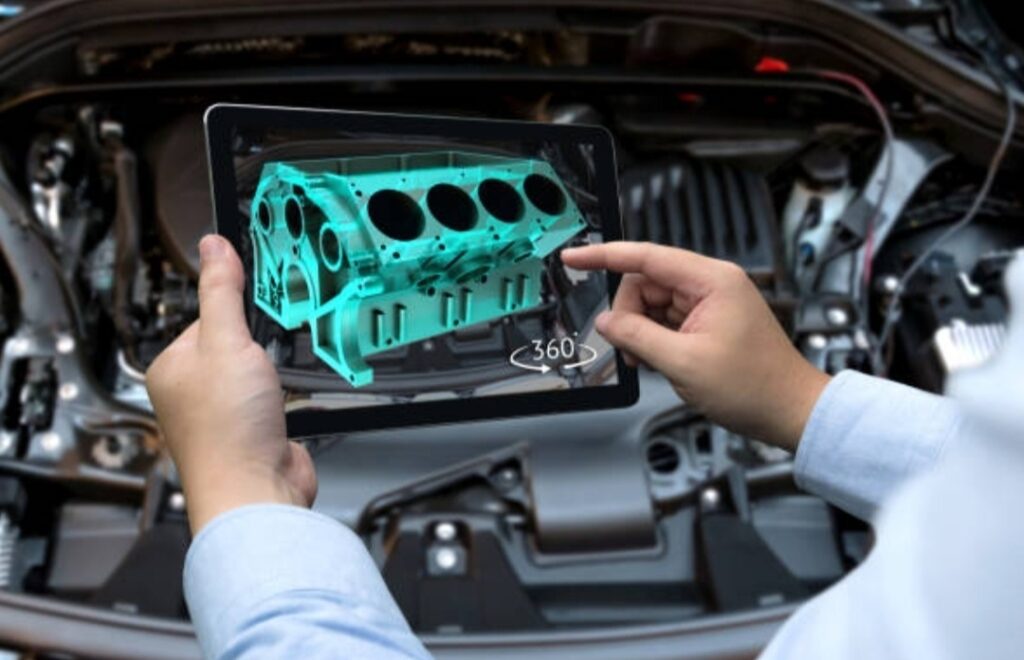
Components of AR Systems
AR systems are composed of both hardware and software components that work together to overlay digital information onto the physical environment.
Hardware Components
- Display Devices: These include smartphones, tablets, AR glasses, and headsets that present augmented content to users. For example, AR glasses like Meta’s Orion prototype aim to replace traditional devices by overlaying digital information directly onto the user’s field of view.
- Sensors: Devices are equipped with sensors such as cameras, accelerometers, gyroscopes, and GPS modules. Cameras capture the real-world environment, while sensors track the device’s orientation and position, enabling accurate placement of virtual objects.
- Processors: Powerful processors are essential for real-time data processing, analyzing sensor inputs, and rendering augmented content. They ensure smooth integration of virtual elements with the physical world.
Software Components
- AR Software Applications: These applications interpret sensor data and manage the rendering of digital content. They utilize computer vision, simultaneous localization and mapping (SLAM), and other algorithms to recognize and track objects within the environment.
- Content Management Platforms: These platforms store and deliver the digital assets used in AR experiences, such as 3D models, animations, and audio. They facilitate the creation, management, and deployment of AR content across different devices.
Types of Augmented Reality
AR can be categorized into several types based on how digital content is anchored to the real world.
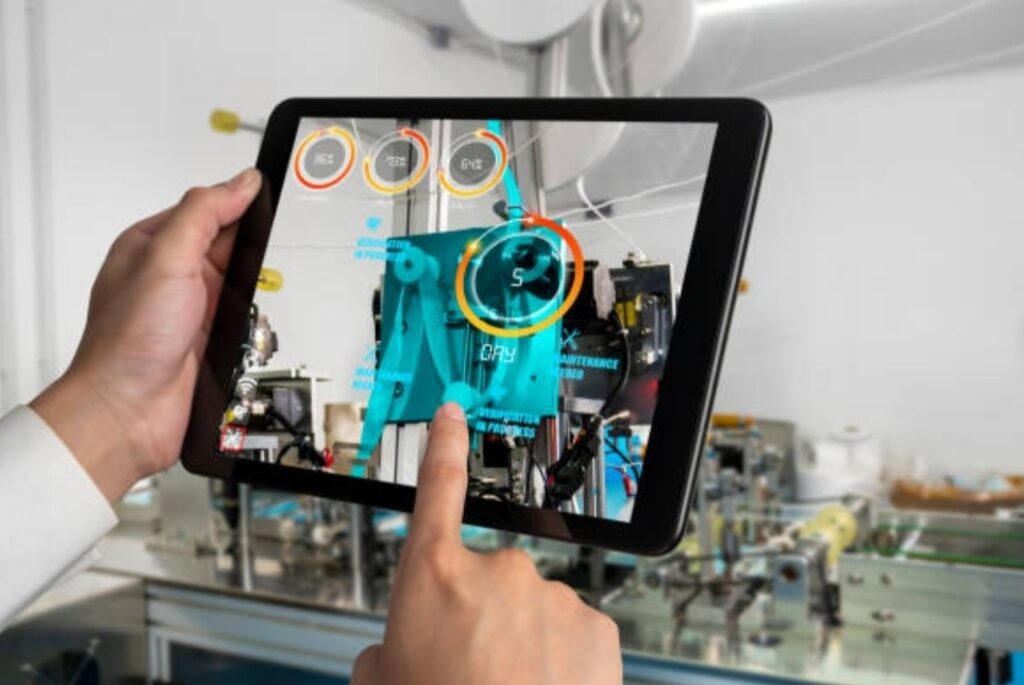
Marker-Based AR
This type utilizes predefined images or patterns, known as markers, to trigger the display of augmented content.
When the device’s camera recognizes a marker, it overlays the corresponding digital information onto the physical marker.
For example, scanning a QR code might display a 3D model or video.
Markerless AR
Also known as location-based AR, this type relies on GPS, accelerometers, and other sensors to determine the user’s position and orientation.
It enables the placement of digital content in relation to the user’s environment without the need for specific markers.
An example is an AR navigation app that overlays directional arrows onto the real world as you move.
Projection-Based AR
This type projects light onto physical surfaces to create interactive displays.
It allows users to interact with digital content without the need for a screen, as the projections can respond to user movements and gestures.
For instance, a projection-based AR system could turn a regular table into an interactive gaming surface.
Superimposition-Based AR
This type replaces or adds to the original view with augmented elements.
It can either partially or fully alter the user’s perception of the real-world object by superimposing digital content.
For example, an AR app could allow users to see how new furniture would look in their living room by overlaying 3D models onto the live camera feed.
By combining these hardware and software components, AR systems create immersive experiences that enhance our interaction with the world around us.
Applications of Augmented Reality in Everyday Life
Augmented Reality (AR) is no longer a futuristic concept—it is transforming multiple industries and seamlessly integrating into our daily lives.
From education and healthcare to retail, navigation, and entertainment, AR enhances experiences, improves efficiency, and provides immersive interactions.
Let’s dive into some of the most impactful real-world applications of AR and explore how it is shaping our world.

Augmented Reality in Education
AR is revolutionizing the way students learn by making education more interactive, engaging, and immersive.
Traditional learning methods often rely on textbooks, static images, and lectures, but AR introduces dynamic 3D models, interactive lessons, and real-time simulations to enhance understanding.
Interactive Learning with AR
- 3D Models & Simulations: AR allows students to explore complex subjects like anatomy, astronomy, and chemistry with lifelike 3D models. Instead of just reading about the solar system, they can interact with planets and stars using AR apps.
- Historical Reconstructions: Imagine standing in an empty field and using AR glasses to witness a historical battle unfold in real time. AR brings history to life, allowing learners to experience the past like never before.
- AR Language Learning: Apps like Mondly AR provide interactive, voice-activated learning experiences where students can converse with virtual characters in different languages, enhancing their speaking and listening skills.
🚀 With AR-powered education, learning is no longer confined to textbooks. It’s engaging, experiential, and tailored to individual needs.
Augmented Reality in Healthcare
The healthcare industry is experiencing a technological revolution with AR improving medical training, diagnostics, and patient care.
Surgeons, doctors, and medical students now rely on AR to enhance precision and understanding.
AR-Powered Medical Training
- Virtual Anatomy Lessons: Medical students can explore life-sized 3D human body models, enabling them to understand anatomy in-depth without needing cadavers.
- Surgical Simulations: AR provides real-time overlays of internal organs, helping surgeons practice complex procedures in a risk-free virtual environment.
- Vein Visualization: AR tools like AccuVein project a digital map of veins onto a patient’s skin, making blood draws and IV insertions easier and reducing discomfort.
💡 AR in healthcare is saving lives, enhancing training, and improving patient outcomes like never before!
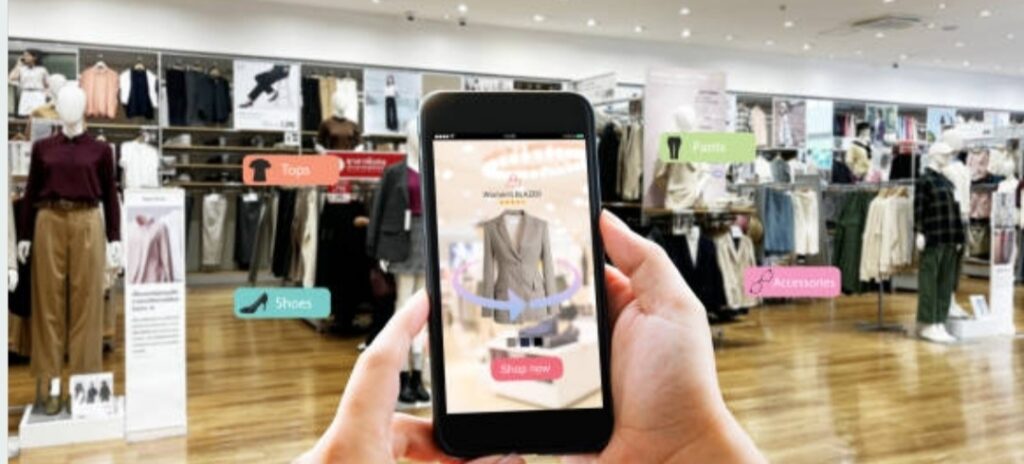
Augmented Reality in Retail & Shopping
AR is reshaping the retail industry by allowing customers to visualize products before purchasing.
This technology bridges the gap between online and in-store shopping, providing an enhanced consumer experience.
Virtual Try-Ons & AR Shopping
- Fashion & Beauty: Apps like Sephora Virtual Artist let users apply virtual makeup to see how products look on their faces before buying.
- Furniture & Home Décor: IKEA’s Place app allows customers to visualize how furniture fits into their homes before making a purchase.
- Shoe Try-On Experiences: Nike uses AR to scan users’ feet and suggest the perfect shoe size, reducing online shopping returns.
💰 AR shopping is increasing sales, reducing returns, and enhancing customer satisfaction across multiple industries!
Augmented Reality in Navigation & Travel
Navigation has evolved beyond traditional maps—AR-powered navigation apps provide real-time visual guidance directly on your smartphone or AR glasses.
AR-Enhanced Directions & Travel Assistance
- Google Maps AR Mode: This feature overlays virtual arrows and street names onto the real world, making it easier to navigate unfamiliar places.
- Airport & Mall Navigation: AR helps travelers navigate large airports and shopping malls by providing step-by-step walking directions.
- Tourism & Exploration: AR apps like Streetmuseum allow travelers to see historical images overlaid onto real-world locations, enhancing their sightseeing experience.
📍 No more getting lost—AR-powered navigation makes travel easier and more intuitive!
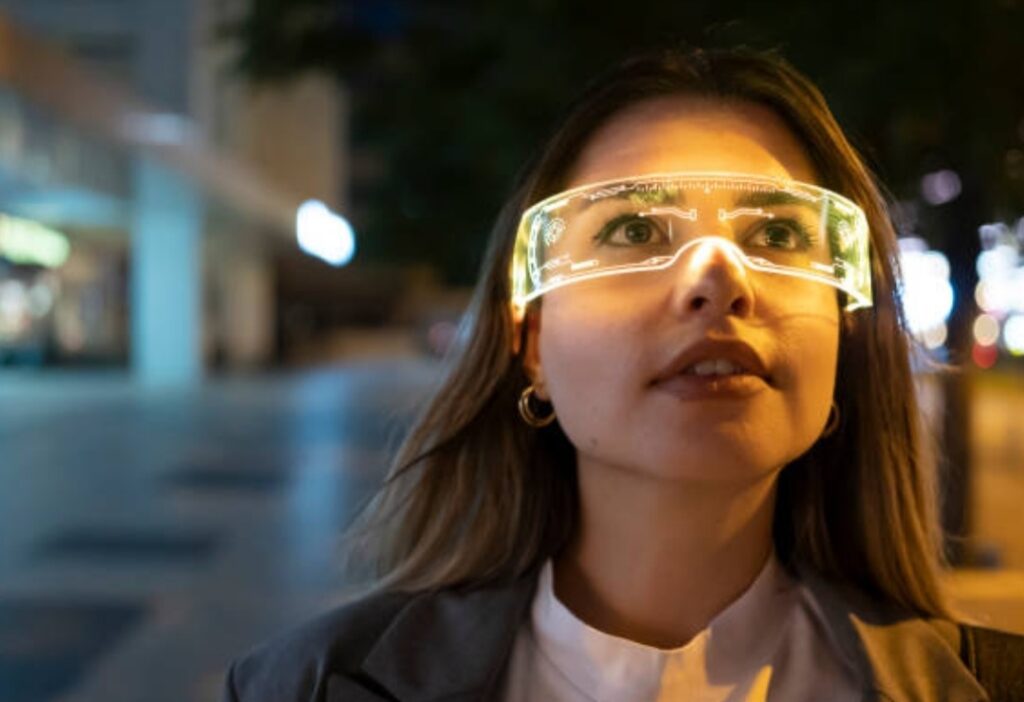
Augmented Reality in Entertainment & Gaming
The entertainment industry has fully embraced AR, creating immersive gaming, interactive movies, and engaging live experiences.
AR Gaming & Interactive Entertainment
- Pokémon Go & AR Mobile Games: Games like Pokémon Go use AR to place virtual creatures in real-world locations, making gaming more interactive and engaging.
- Live Concerts & AR Performances: Some concerts use AR holograms and virtual effects to create mind-blowing performances.
- AR Sports & Fitness: Apps like Zwift combine virtual cycling with real-world workouts, allowing users to compete in digital races from home.
🎮 AR entertainment is bringing fantasy into reality, making experiences more interactive than ever before!
The Future of Augmented Reality in Everyday Life
As AR technology continues to advance, its applications will expand even further, making everyday activities more interactive, convenient, and efficient.
Whether in education, healthcare, retail, navigation, or entertainment, AR is reshaping the way we experience the world.
🚀 Are you ready to embrace the future? Try out some of the latest AR apps today and experience firsthand how augmented reality is changing the way we live, learn, and interact!
👉 Discover the best AR apps and devices here!
Advantages and Challenges of Augmented Reality
Augmented Reality (AR) is reshaping industries, enhancing digital experiences, and revolutionizing how people interact with the world.
However, like any cutting-edge technology, it comes with both benefits and challenges.
In this section, we will explore the advantages and challenges of augmented reality, providing insights into how this technology is improving lives while also facing hurdles that need to be addressed.
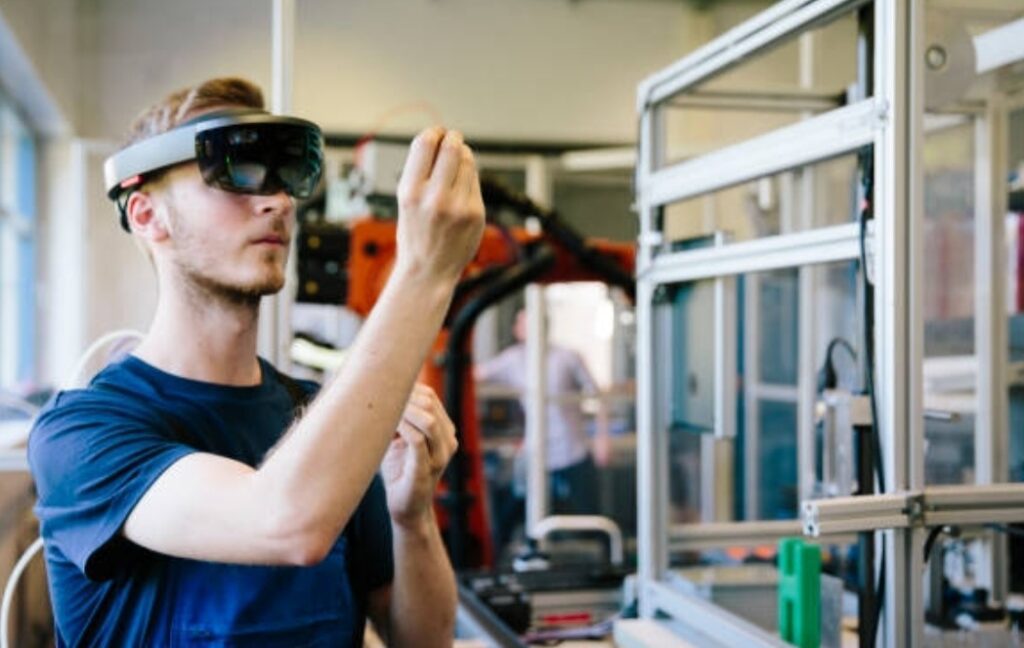
Advantages of Augmented Reality
AR offers numerous benefits across different industries, from enhanced user experiences to improved training, education, and business engagement.
Companies that integrate AR into their products and services gain a competitive edge by offering interactive and immersive experiences.
Enhanced User Experience with AR
One of the biggest advantages of augmented reality is its ability to create highly engaging and interactive user experiences.
Unlike traditional digital content, which is confined to screens, AR overlays virtual elements onto the real world, making experiences feel more natural and immersive.
- Real-Time Interaction: AR enables real-time interaction with digital objects, allowing users to manipulate, rotate, and explore 3D elements.
- Seamless Integration: AR blends virtual and physical environments, making digital interactions feel intuitive and enhancing overall usability.
- Improved Product Visualization: Customers can preview products in real-world environments before making purchasing decisions, reducing uncertainty and enhancing satisfaction.
🚀 AR creates an engaging, hyper-realistic experience that makes digital interactions more seamless and enjoyable.
Improved Training and Education
Augmented reality is transforming learning and professional training by offering practical, hands-on experiences in a virtual environment.
- Medical Training: AR allows medical students and surgeons to practice procedures on lifelike 3D models, enhancing their skills without risk to real patients.
- Workplace Training: Industries like manufacturing, aviation, and military use AR simulations to provide hands-on training, improving worker efficiency and safety.
- STEM Education: AR brings science and mathematics concepts to life, allowing students to interact with dynamic 3D models of molecules, engines, or historical sites.
📚 Learning with AR is interactive, engaging, and effective, helping students and professionals grasp complex concepts faster!
Increased Engagement and Brand Interaction
For businesses, augmented reality boosts engagement, increases customer retention, and improves brand awareness.
Companies use AR to create interactive marketing campaigns, virtual storefronts, and immersive experiences that capture attention.
- Retail & E-commerce: AR lets shoppers try on clothing, makeup, and accessories virtually, reducing return rates and improving shopping confidence.
- Advertising & Marketing: Brands use AR-powered advertisements to create interactive experiences, allowing users to explore products in 3D before making a purchase.
- Event & Trade Shows: Companies use AR at events and exhibitions to provide interactive product demos, attracting more visitors and increasing sales.
🎯 AR-powered marketing strategies result in higher engagement, better conversion rates, and a stronger brand presence!

Challenges of Augmented Reality
Despite its numerous advantages, AR technology faces several challenges that must be addressed for widespread adoption.
These include privacy concerns, technical limitations, and user adoption barriers.
Privacy Concerns and Data Security
One of the biggest concerns surrounding AR is user privacy and data security.
Since AR applications rely on cameras, location data, and real-time tracking, they pose potential risks for personal data misuse.
- Continuous Data Collection: AR devices constantly collect and process data about the user’s surroundings, raising concerns about how this information is stored and shared.
- Unauthorized Surveillance: Malicious actors could exploit AR for real-time tracking, leading to security risks and potential misuse of personal information.
- Data Breaches & Cyber Threats: If AR applications are not properly secured, they could become targets for cyberattacks, identity theft, or unauthorized access to sensitive data.
🔐 As AR evolves, companies must implement robust privacy measures to protect user data and ensure ethical AR development.
Technical Limitations and Hardware Requirements
AR requires advanced hardware and software to function optimally. While technology is improving, some limitations still prevent AR from reaching its full potential.
- High Processing Power: AR applications require powerful processors and high-resolution displays, which consume a lot of battery life on mobile devices.
- Expensive Hardware: High-end AR headsets like Microsoft HoloLens and Magic Leap are expensive, making them inaccessible to many consumers and businesses.
- Latency & Connectivity Issues: AR relies on fast internet connections and high-speed data processing, but network latency and limited 5G availability can affect performance.
⚙️ For AR to become truly mainstream, hardware needs to become more affordable, efficient, and accessible.
User Adoption and Accessibility Challenges
While AR is growing rapidly, not everyone is ready to adopt the technology due to various barriers, including lack of awareness, accessibility issues, and user discomfort.
- Learning Curve: Many users find AR difficult to understand, requiring tutorials or onboarding before they feel comfortable using AR applications.
- Compatibility Issues: Some AR apps require specific devices or software versions, limiting accessibility for people with older smartphones or incompatible operating systems.
- Motion Sickness & Eye Strain: Prolonged use of AR headsets can cause discomfort, dizziness, or fatigue, making it difficult for users to engage with AR for extended periods.
📉 To drive widespread adoption, AR developers must focus on user-friendly designs, seamless integration, and reducing discomfort for long-term use.
The Future of Augmented Reality
AR is an exciting, transformative technology that is already making a significant impact on industries like education, healthcare, retail, and entertainment.
While there are challenges to overcome, advancements in hardware, privacy measures, and accessibility will drive AR adoption even further.
🔮 The future of augmented reality is bright! As technology evolves, AR will become more accessible, efficient, and widely integrated into daily life.
👉 Discover the latest AR innovations and devices here!
The Future of Augmented Reality in Everyday Technology
Augmented reality (AR) is rapidly evolving, and its integration into everyday technology is becoming more seamless than ever.
As AR continues to develop, it will transform industries, reshape social interactions, and enhance workplace productivity.
In this section, we will explore the latest emerging trends in AR and its potential impact on our daily lives.
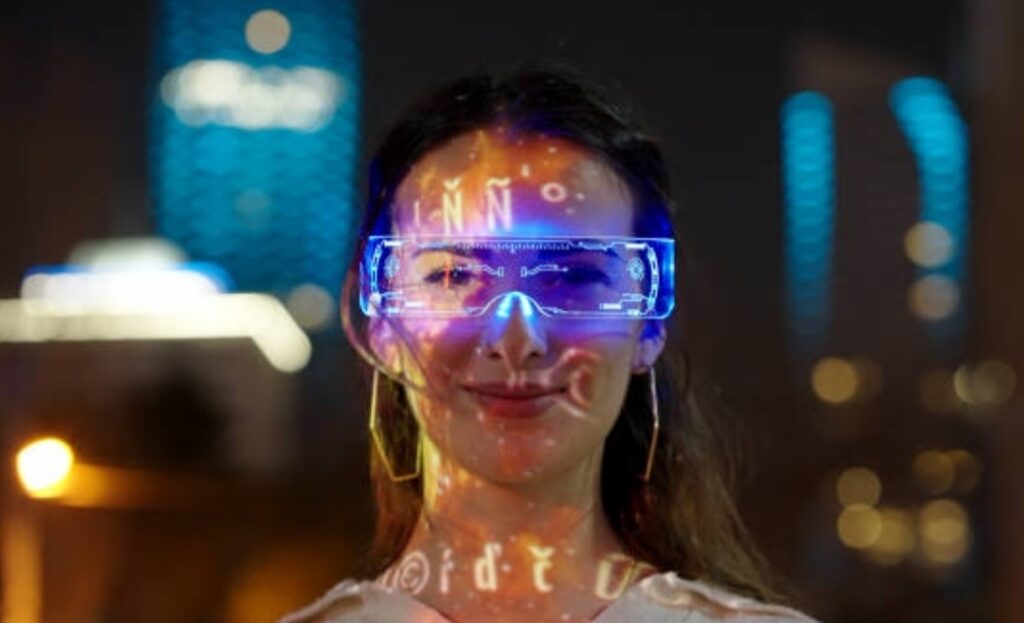
Emerging Trends in Augmented Reality
The future of augmented reality is driven by cutting-edge innovations, making AR more intelligent, wearable, and accessible.
With the integration of artificial intelligence, wearable technology, and cloud computing, AR is becoming a powerful tool across different sectors.
Integration with Artificial Intelligence (AI) for Smarter AR Experiences
One of the most exciting advancements in AR is its fusion with artificial intelligence (AI).
AI-powered AR enhances real-time interactions, object recognition, and personalized experiences, making AR applications more intuitive and responsive.
- Enhanced Object Recognition: AI helps AR applications recognize and analyze objects, faces, and environments in real time.
For example, AR shopping apps use AI to suggest personalized product recommendations based on user preferences. - Smart Assistance & Automation: AI-powered AR virtual assistants can provide real-time guidance in various fields, from medical surgeries to home repairs.
Imagine wearing AR glasses that analyze machinery and offer step-by-step repair instructions instantly! - Advanced Machine Learning (ML) Algorithms: With AI and ML, AR applications continuously learn from user interactions, making them more accurate and adaptive over time.
🤖 The integration of AI and AR will make digital experiences smarter, more personalized, and highly efficient!
The Rise of Wearable AR Devices – Smart Glasses & AR Contact Lenses
The future of augmented reality is moving away from handheld devices and toward wearable technology.
This shift will make AR experiences more natural, hands-free, and seamlessly integrated into everyday life.
- Smart Glasses: Companies like Apple, Meta, and Google are investing heavily in next-generation AR glasses that overlay digital content onto the real world.
These glasses will replace smartphones by offering hands-free navigation, real-time translations, and interactive holograms. - AR Contact Lenses: The development of smart contact lenses will take AR to a whole new level.
Imagine accessing digital information directly on your retina, eliminating the need for screens! - Immersive Workplace Tools: Industries like healthcare, construction, and logistics will benefit from AR glasses that provide real-time data, step-by-step guidance, and hands-free operations.
🕶️ With the rise of wearable AR devices, digital interactions will become more immersive and effortless than ever before!
The Potential Impact of Augmented Reality
The integration of AR into daily life will reshape industries, enhance social interactions, and revolutionize workplace productivity.
Let’s explore how AR will impact key areas of our lives in the near future.
Workplace Transformation – How AR Will Change the Future of Work
AR will redefine workplace environments by introducing more interactive, collaborative, and efficient solutions.
Industries like healthcare, retail, education, and corporate businesses will leverage AR to increase productivity and engagement.
- Remote Collaboration: With AR, remote teams can work together in shared virtual spaces, making meetings and brainstorming sessions more interactive and engaging.
- Hands-Free Training & Assistance: Workers can use AR headsets to receive real-time instructions, reducing the need for manual training and improving efficiency.
- Enhanced Productivity: AR-powered tools will help professionals analyze real-time data, improving decision-making and workflow automation.
🏢 In the future, AR will make workplaces smarter, more connected, and highly efficient!
Augmented Reality & Social Interactions – A New Way to Connect
AR is set to revolutionize social interactions by introducing new ways for people to connect, share, and communicate in immersive digital spaces.
- AR-Enhanced Social Media: Social platforms will offer AR-powered filters, holograms, and interactive experiences, allowing users to engage with digital content in real-world environments.
- Virtual AR Meetups & Events: People will be able to attend virtual concerts, meetups, and global events using AR-powered headsets, making long-distance social interactions feel real.
- Hyper-Personalized Messaging: AR will enable holographic video calls and interactive messaging, bringing a new dimension to digital communication.
🎭 With AR-driven social interactions, virtual connections will feel more immersive and lifelike than ever before!
What’s Next for Augmented Reality?
The future of augmented reality is incredibly exciting, with innovations that will redefine how we work, communicate, and interact with technology.
From AI-driven AR experiences to wearable smart glasses and workplace transformation, AR is on its way to becoming a mainstream technology.
🚀 Are you ready for the future of AR? Stay ahead of the game by exploring the latest AR gadgets, applications, and trends!
👉 Discover the Best AR Devices & Apps Here!
FAQs – Frequently Asked Questions About Augmented Reality
Augmented reality (AR) is rapidly transforming how we interact with digital content.
Many people still have questions about its uses, impact, and future potential.
Below are the most commonly asked questions to help you better understand AR and its applications.

What is Augmented Reality?
Augmented reality (AR) is a technology that overlays digital information—such as images, sounds, or 3D objects—onto the real world using devices like smartphones, AR glasses, or tablets.
Unlike virtual reality (VR), which immerses users in a fully digital environment, AR enhances the real-world environment by adding interactive digital elements.
Some common examples of augmented reality include:
- AR Filters on Social Media – Snapchat and Instagram filters that modify facial features or surroundings.
- Google AR Search – Allows users to view 3D animals or objects in their real environment.
- AR Navigation Apps – Google Maps’ AR mode provides turn-by-turn directions overlaid on real streets.
- AR Gaming – Pokémon GO and other AR-powered games bring digital creatures into the real world.
🚀 Want to experience AR? Try out the latest AR apps and devices to see its power in action!
How Does Augmented Reality Work?
AR works by using cameras, sensors, AI, and real-time data processing to blend digital content with the real world.
The process typically involves:
- Capturing the Environment – AR-enabled devices use cameras and sensors to scan surroundings.
- Processing Data in Real-Time – AI algorithms analyze spatial information and detect surfaces.
- Overlaying Digital Content – The system places 3D models, animations, or information over the physical space.
- Interacting with Users – AR allows users to manipulate digital elements by moving, touching, or adjusting perspectives.
🔍 Fun Fact: AR technology is often powered by machine learning, AI, and 5G connectivity to deliver seamless experiences.
What Are the Different Types of Augmented Reality?
There are four main types of AR, each serving different purposes:
- Marker-Based AR (Image Recognition)
- Uses a camera to scan a predefined marker (like a QR code or image) to display digital content.
- Example: AR business cards that display interactive elements when scanned.
- Markerless AR (Location-Based AR)
- Uses GPS, accelerometers, and gyroscopes to place AR objects without requiring a marker.
- Example: Google Maps AR mode and Pokémon GO.
- Projection-Based AR
- Projects digital images directly onto real-world surfaces without requiring a screen.
- Example: Holograms used in concerts or museum exhibits.
- Superimposition-Based AR
- Replaces part of the real-world view with an augmented version.
- Example: AR-assisted surgery where digital overlays guide surgeons in real time.
🌟 Want to see AR in action? Check out the best AR apps for your smartphone today!
What Are the Benefits of Augmented Reality?
Augmented reality offers numerous benefits across various industries, including:
- Enhanced Shopping Experience – AR lets customers try on clothes, glasses, or furniture virtually before purchasing.
- Improved Learning & Training – Medical students, engineers, and pilots use AR simulations for hands-on training.
- Boosted Workplace Productivity – AR helps remote teams collaborate more effectively with 3D models and virtual workspaces.
- Revolutionized Entertainment & Gaming – AR creates immersive storytelling and interactive gameplay experiences.
🎯 Want to explore AR’s potential? Check out these innovative AR-powered tools!

How is Augmented Reality Used in Business?
Many businesses are adopting AR to enhance customer engagement, streamline operations, and boost sales.
Here are some of the most common business applications of AR:
- Retail & E-Commerce – Virtual try-ons, 3D product visualization, and AR-powered shopping experiences.
- Healthcare – AR-assisted surgeries, remote medical consultations, and advanced diagnostics.
- Real Estate & Architecture – 3D property tours and AR-based home design planning.
- Manufacturing & Maintenance – AR-guided repair instructions and hands-free industrial training.
- Marketing & Advertising – Interactive AR ads, branded filters, and immersive product launches.
📈 Want to implement AR in your business? Learn how top companies are leveraging AR for growth!
What Is the Future of Augmented Reality?
AR is expected to become even more advanced and accessible in the coming years.
Here are some future trends to watch for:
- AR Smart Glasses & Contact Lenses – Devices like Apple Vision Pro and Meta’s AR glasses will replace smartphones as primary AR platforms.
- 5G-Powered AR Experiences – Faster data speeds will enable smoother, real-time AR applications for gaming, shopping, and work.
- AI-Integrated AR – Machine learning will personalize AR experiences, adapting them based on user preferences.
- AR in Smart Cities – Real-time AR navigation, public information overlays, and interactive tourism experiences.
- Healthcare Innovations – AR will continue revolutionizing telemedicine, surgery, and patient care.
🔮 Want to stay ahead in AR? Follow the latest AR news and discover cutting-edge AR technology!
How Can I Start Using Augmented Reality Today?
Getting started with AR is easier than ever!
Here are some ways you can explore AR technology today:
- Download AR Apps – Try popular AR apps like Snapchat, Instagram, Google Lens, and IKEA Place.
- Use AR Shopping Features – Amazon, Sephora, and Nike offer virtual try-ons for products.
- Explore AR Gaming – Play games like Pokémon GO or Harry Potter: Wizards Unite.
- Try AR on Social Media – Use AR-powered filters and interactive stories on Instagram and TikTok.
- Invest in AR Devices – Buy AR headsets, smart glasses, or holographic displays to experience advanced AR applications.
🚀 Curious about AR devices? Check out the best AR headsets available now!
Is Augmented Reality the Future?
Augmented reality is not just a passing trend—it is reshaping industries, changing consumer behaviors, and enhancing real-world interactions.
As technology advances, AR will become more immersive, accessible, and deeply integrated into daily life.
Whether you’re a tech enthusiast, business owner, or casual user, now is the perfect time to embrace AR and explore its limitless possibilities!
🔥 Don’t get left behind! Start using AR today and stay ahead of the tech revolution!
👉 Discover the latest AR innovations and tools here!
Conclusion of Augmented Reality
Augmented reality (AR) is no longer a futuristic concept—it is actively transforming industries, revolutionizing digital interactions, and reshaping the way we experience technology.
From enhanced user experiences in gaming and retail to groundbreaking applications in healthcare, education, and workplace productivity, AR is blurring the lines between the physical and digital worlds.
As AR technology continues to evolve, its impact on daily life will become even more profound.
Let’s recap the key takeaways and explore what the future holds for AR.
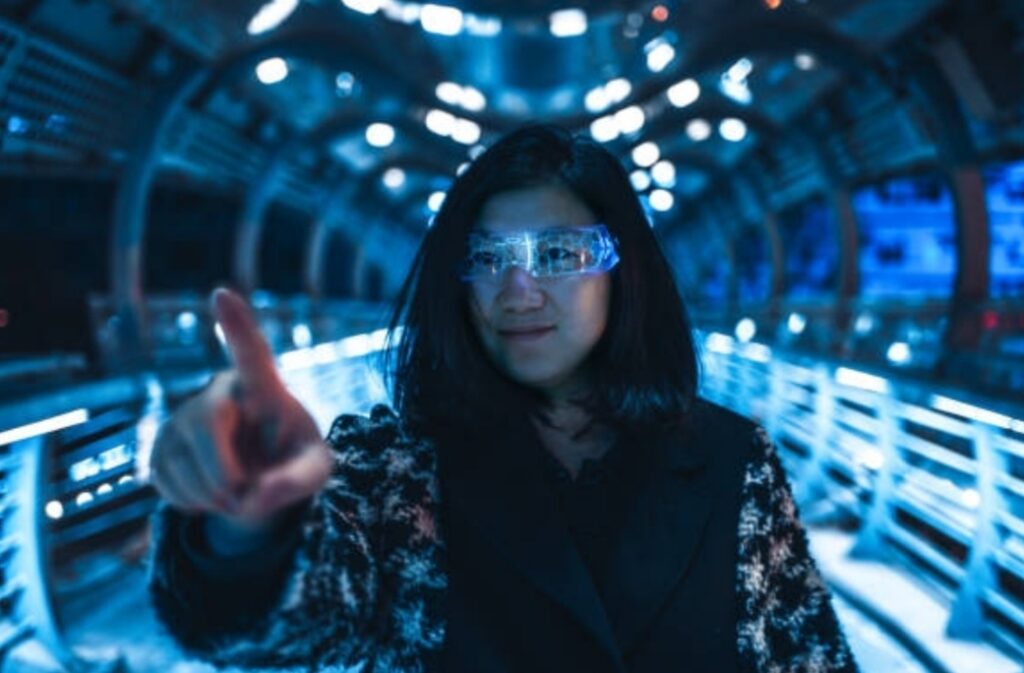
Recap – How Augmented Reality is Changing the World
The rapid adoption of AR has led to transformative innovations across multiple industries.
Let’s take a quick look at how AR is reshaping various sectors:
- Retail & E-Commerce: AR-powered virtual try-ons and immersive shopping experiences allow customers to preview products before making a purchase, enhancing confidence and reducing returns.
- Healthcare & Medical Training: AR is assisting surgeons with real-time 3D overlays, improving diagnosis, precision, and medical education.
- Education & Training: AR brings interactive learning to classrooms, enabling students to engage with historical events, science experiments, and complex concepts in 3D.
- Workplace & Collaboration: AR-driven tools are revolutionizing remote work, hands-free training, and industrial manufacturing, increasing efficiency and productivity.
- Gaming & Entertainment: AR has transformed gaming with immersive experiences, bringing digital elements into the real world with apps like Pokémon GO and AR escape rooms.
🚀 AR is more than just a trend—it’s a technological revolution that is reshaping how we interact with digital content!
Final Thoughts – The Future of Augmented Reality
As technology advances, augmented reality will continue to seamlessly integrate into everyday life.
Here’s what the future holds for AR:
- Smarter AR Glasses & Wearables: The transition from smartphones to AR-powered smart glasses will redefine how we access information, interact with content, and communicate.
- AI-Powered AR Experiences: The combination of artificial intelligence (AI) and AR will lead to hyper-personalized, context-aware applications that adapt to individual users in real time.
- 5G & Cloud-Based AR: The rise of 5G technology and cloud computing will enable real-time AR experiences without the need for bulky hardware.
- AR in Smart Cities: AR will play a role in urban planning, navigation, and public services, offering real-time data overlays for directions, safety alerts, and interactive city experiences.
🌟 The future of AR is bright, and its potential is limitless!
Are You Ready for the AR Revolution?
The world is moving toward a future where AR becomes a daily necessity rather than just a novelty.
Businesses, content creators, and tech enthusiasts must stay ahead by adopting AR-driven innovations.
🔥 Don’t miss out on the next big tech shift! Stay updated with the latest AR trends and explore how you can leverage this technology for business, entertainment, and beyond.
👉 Discover the Best Augmented Reality Tools & Gadgets Here!
🎯 What are your thoughts on the future of AR? Let us know in the comments!
You might also like :

